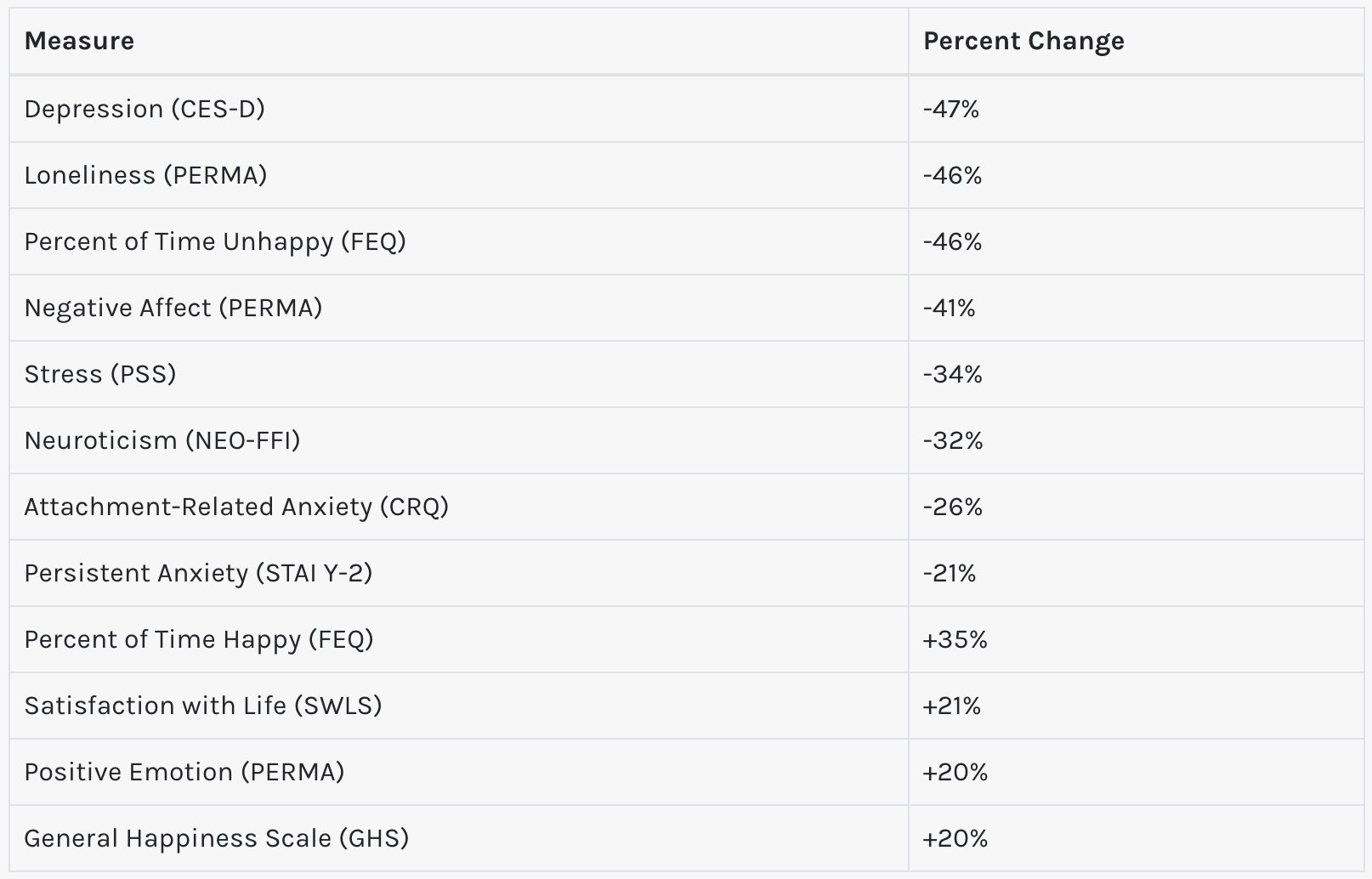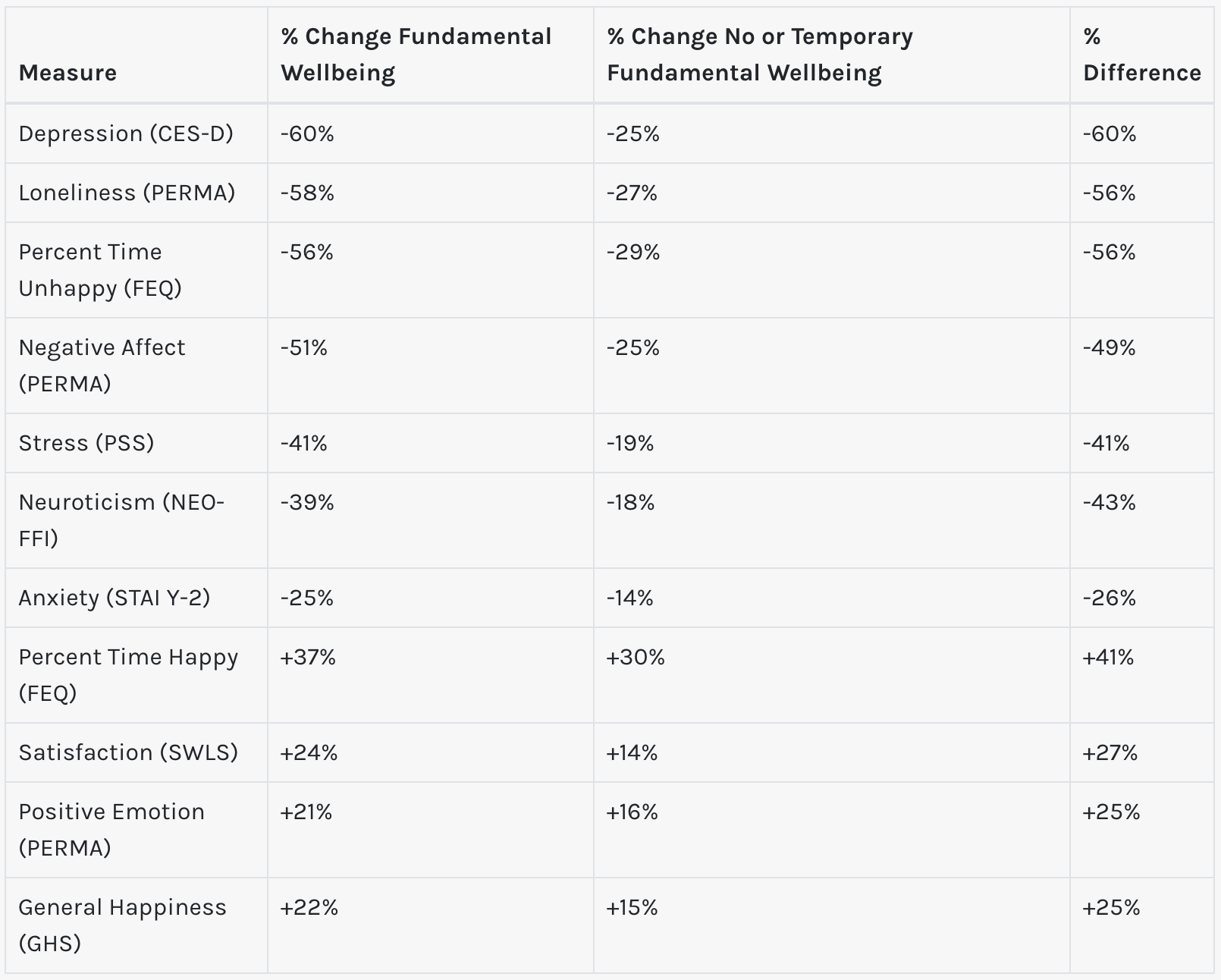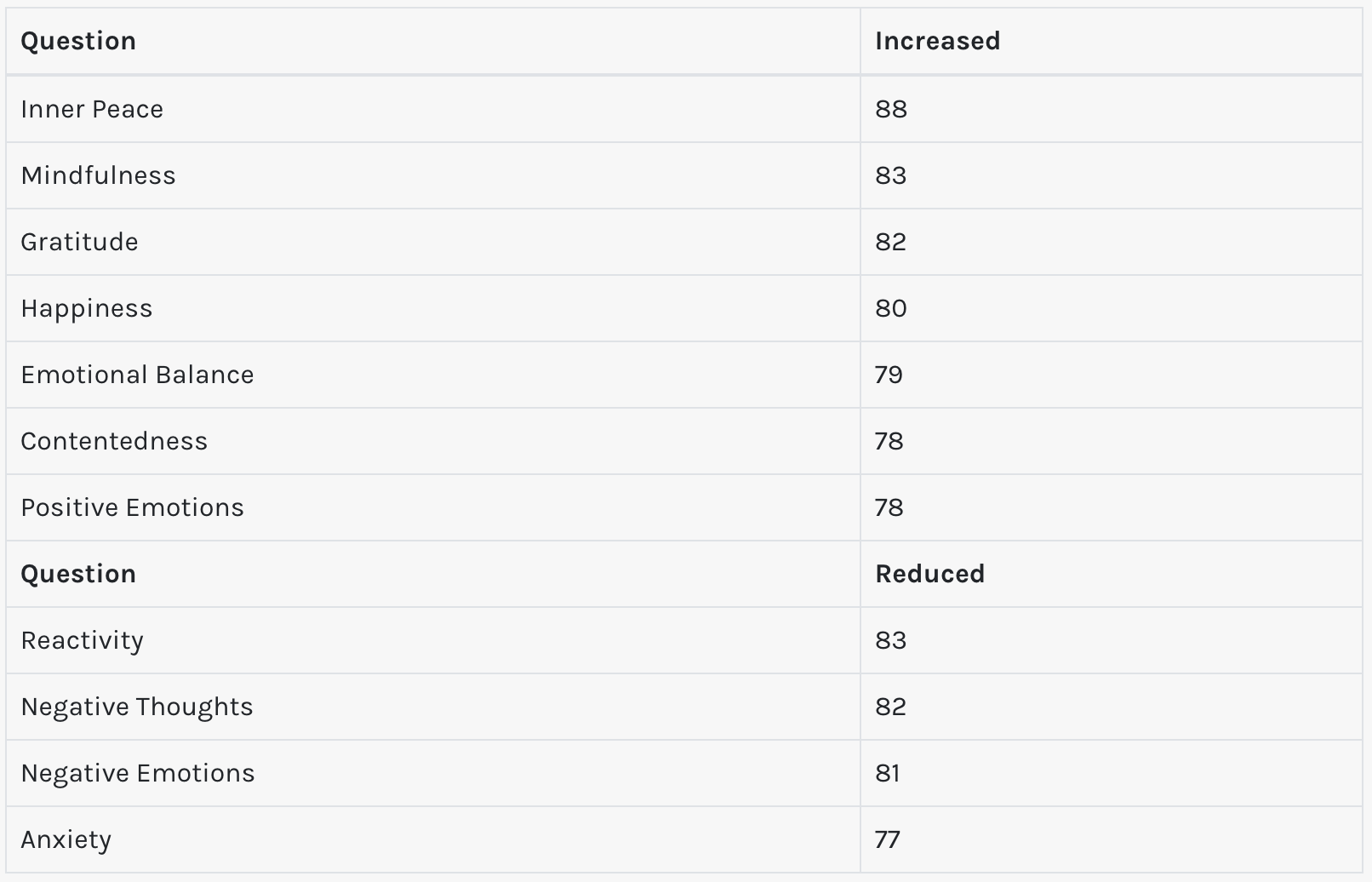Center for the Study of
Non-Symbolic Consciousness
A Very Brief Look At Some Data:
The research project has generated a massive amount of data on Fundamental Wellbeing over the last 15 years. It seems appropriate to include a small taste of it for those of you who are interested in it. A great deal more is available on the center’s website (http://nonsymbolic.org). Fundamental Wellbeing is our public "catch-all" term for ways of experiencing the world such as: persistent awakening, nonduality, enlightenment, the peace that passeth understanding, unity consciousness, and hundreds of similar terms and descriptions.
Since 2014 the project has been running a first-of-its-kind experiment known as the Finders Course to collect psychological and physiological data on people before and after their transition to Fundamental Wellbeing. The data from eleven Finders Course experiments have been analyzed (2014-2018). Four hundred and fifty-five participants have successfully completed the program. Of these, three hundred and nineteen (or an incredible 70%) of those who completed it reported a transition to Fundamental Wellbeing. And, a majority of the remaining participants reported at least temporary glimpses of Fundamental Wellbeing during the program.
Of these, three hundred and nineteen (or an incredible 70%) of those who completed it reported a transition to Fundamental Wellbeing. And, a majority of the remaining participants reported at least temporary glimpses of Fundamental Wellbeing during the program.
At this point the program has included people from six continents and dozens of countries, including many who speak English as a second language. Ages have ranged from twenty-one to eighty-one. People came from a wide range of backgrounds and professions. A broad range of gold standard psychology measures was used to collect data from each cohort, including the following:
CES-D: Center for Epidemiological Studies Depression Scale
PERMA: Positive emotion, Engagement, Relationships, Meaning Accomplishment
FEQ: Fordyce Emotions Questionnaire
PSS: Perceived Stress Scale
NEO-FFI: Neuroticism-Extraversion-Openness Five-Factor Inventory
CRQ: Close Relationships Questionnaire
STAI-Y2: State-Trait Anxiety Inventory (Trait Anxiety)
SWLS: Satisfaction with Life Scale
GHS: General Happiness Scale
The table below shows the percentage change for participants who completed the program for several of the major measures. Some measures were rotated in and out over time, so not all measures were given to each participant. If you’re familiar with these measures from other research, the changes will seem huge to you. They are. Overall the program has a massive impact on participant wellbeing. Also note the large drop in the personality trait Neuroticism. Personality traits are supposed to be relatively durable over time, so a drop like this over a four-month program is remarkable. Importantly, all changes are highly statically significant (p < 0.00001).
Percentage of change for participants from beginning of Finder’s Course to completion.

Another way to look at the data is to ask if there is a difference between participants who reported a transition to Fundamental Wellbeing (Fundamental Wellbeing) or not by the end of the program. The no Fundamental Wellbeing, or no or temporary Fundamental Wellbeing, category includes both those who experienced temporary Fundamental Wellbeing as well as no glimpses of Fundamental Wellbeing at all. Recall that most people in this category would have experienced at least some glimpses of Fundamental Wellbeing.
Longitudinal research, including at least one project that spanned decades, have shown that glimpses of Fundamental Wellbeing are often regarded by people as among the most transformative and significant experiences of their lives. In fact, we do see quite remarkable improvements in the no or temporary Fundamental Wellbeing group. However, it is not nearly as profound as changes experienced by those reporting Fundamental Wellbeing.
If a glimpse was as transformative as a full transition to Fundamental Wellbeing, we’d expect to see the two groups being close together in their numbers. In fact, they are quite far apart. It’s very clear that the group that experiences Fundamental Wellbeing is in a very different place in terms of their experience of the world than the group that does not. Importantly, the difference between the groups on every measure is highly statically significant (p < 0.00001).
The “% Difference” column in the table below might seem confusing to you. It is calculated on the difference between the ending score for each group. So, for example, let’s say the total score for a happiness measure was between 0 (miserable) and 100 (gloriously happy). If the Fundamental Wellbeing group’s final score was 100, and the no or temporary Fundamental Wellbeing group’s final score was 50, the Fundamental Wellbeing group would be 100% happier than the no or temporary Fundamental Wellbeing group. You can see a lot more about these types of changes on our academic website, in some of my detailed presentations.
Percentage of change for participants from beginning of Finder’s Course to completion

In addition to using gold-standard psychology questionnaires, participants were also asked some general questions, such as if they had more inner peace after the program. The results from some of those questions are in the table below. These numbers are not the amount of increase, just the number of people that reported more or less of a given experience as a result of the course.
Top percentage categories for all participants who completed course

The two tables below compare the scores for participants who reported transitioning into Fundamental Wellbeing versus those who did not. Although most categories are the same, notice that the lowest score in the Fundamental Wellbeing list is well above the highest score in the no or temporary Fundamental Wellbeing list. Also notice the categories that are different. The Fundamental Wellbeing list includes two categories that the no or temporary Fundamental Wellbeing list does not: Emotional Balance and Contentedness. Conversely, the no or temporary Fundamental Wellbeing list also has two unique categories: Gratitude and Tolerance of Others.
Consider the difference between these four items. Two of them are nearly impossible to will yourself to control: Emotional Balance and Contentedness. Although many people try to force states like these to occur, ultimately these just happen. They really cannot be willed or forced to occur without causing their opposite.
Now consider the other two items from the no or temporary Fundamental Wellbeing list: Gratitude and Tolerance of Others. While wonderful attributes, these can be forced. You can make yourself feel gratitude, for instance. Of course, these can also naturally arise, but in many ways these two items highlight a key difference in Fundamental Wellbeing.
The traits that comprise the psychological experience of Fundamental Wellbeing often just arise with no additional action needed. It is literally a new norm that appears in one’s experience, not something that has to be actively maintained in each moment. It becomes as natural as breathing.
Another thing to note in the tables below is that, even for the highest category in the no or temporary Fundamental Wellbeing list, the Fundamental Wellbeing group has a higher reported percentage. In other words, participants reporting Fundamental Wellbeing at the end of the course also reported higher levels of both Gratitude and Tolerance of Others. Also, notice how rapidly the top scores for the no Fundamental Wellbeing group drop off compared to the participants who reported Fundamental Wellbeing.
Top 5 percentage categories where ‘more is better’ for participants who completed course that reported Fundamental Wellbeing (FW) vs. no Fundamental Wellbeing (nFW)

Top 5 percentage categories where ‘more is better’ for participants who completed course that reported no Fundamental Wellbeing (nFW) vs. Fundamental Wellbeing (FW)

What about items that are ideal to have go down, like negative thoughts and emotions? Here again we see key differences between the two groups, and our previous observations hold up. The lowest score for the Fundamental Wellbeing group is still above the highest score for those who didn’t report experiencing it, there are huge differences in the percentage reporting being in the various categories between the two groups, and so on.
All of the categories are shared between the groups, except for two. A large reduction is reported in internal mental chatter in the Fundamental Wellbeing group but not in the no Fundamental Wellbeing group. As outlined in this book and many of our other materials, the reduction of internal narrative is a key component of Fundamental Wellbeing. The other difference is a reduction in conflict that shows up as one of the categories for those who do not experience Fundamental Wellbeing, though at a far lower level than for those who do.
Top 5 percentage categories where ‘less is better’ for participants who completed course that reported Fundamental Wellbeing (FW) vs. no Fundamental Wellbeing (nFW)

Top 5 percentage categories where ‘less is better’ for participants who completed course that reported no Fundamental Wellbeing (nFW) vs. Fundamental Wellbeing (FW)

We were fortunate to have this project be the first in modern history that could reliably, safely and rapidly produce a transition in such a high percentage of people into Fundamental Wellbeing, and thus allow tracking the before and after changes. No matter how this data is examined, it is clear that these are two groups of people who are experiencing the world through very different internal lenses. Both groups improved significantly across major scientific measures of wellbeing, emotion, personality, and more. In fact, if the experimental protocol had only produced the changes seen in the group that did not report Fundamental Wellbeing, it would have been a smashing success.
As incredible as the changes for all participants were, the results reported by Finders across the entire spectrum were significantly and measurably higher. It’s completely clear which group you’d want to be in, given the opportunity. The good news is that you can be!